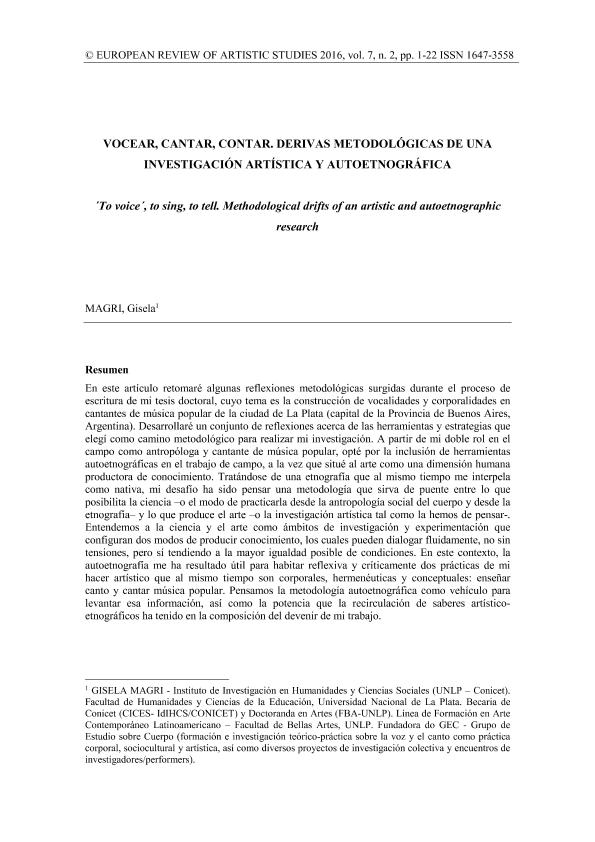Artículo
En este artículo retomaré algunas reflexiones metodológicas surgidas durante el proceso de escritura de mi tesis doctoral, cuyo tema es la construcción de vocalidades y corporalidades en cantantes de música popular de la ciudad de La Plata (capital de la Provincia de Buenos Aires, Argentina). Desarrollaré un conjunto de reflexiones acerca de las herramientas y estrategias que elegí como camino metodológico para realizar mi investigación. A partir de mi doble rol en el campo como antropóloga y cantante de música popular, opté por la inclusión de herramientas autoetnográficas en el trabajo de campo, a la vez que situé al arte como una dimensión humana productora de conocimiento. Tratándose de una etnografía que al mismo tiempo me interpela como nativa, mi desafío ha sido pensar una metodología que sirva de puente entre lo que posibilita la ciencia –o el modo de practicarla desde la antropología social del cuerpo y desde la etnografía– y lo que produce el arte –o la investigación artística tal como la hemos de pensar-. Entendemos a la ciencia y el arte como ámbitos de investigación y experimentación que configuran dos modos de producir conocimiento, los cuales pueden dialogar fluidamente, no sin tensiones, pero sí tendiendo a la mayor igualdad posible de condiciones. En este contexto, la autoetnografía me ha resultado útil para habitar reflexiva y críticamente dos prácticas de mi hacer artístico que al mismo tiempo son corporales, hermenéuticas y conceptuales: enseñar canto y cantar música popular. Pensamos la metodología autoetnográfica como vehículo para levantar esa información, así como la potencia que la recirculación de saberes artístico-etnográficos ha tenido en la composición del devenir de mi trabajo. In this article, I will return to some surgical methodological reflections during the writing process of my doctoral thesis, whose theme is the construction of vocalities and corporalities in popular music singers from the city of La Plata (capital of the Province of Buenos Aires, Argentina). To develop a set of reflections about the tools and strategies that I chose as the methodological path to carry out my research. Starting from my double role in the field as an anthropologist and popular music singer, I opted for the inclusion of autoethnographic tools in the field work, at the same time that I placed art as a human dimension that produces knowledge. In the case of an ethnography that at the same time challenges me as a native, my challenge has been to think of a methodology that serves as a bridge between what science makes possible - or the way of practicing it from the social anthropology of the body and from ethnography - and what produce art - or artistic research as we have to think of it. We understand science and art as methods of investigation and experimentation that configure two modes of knowledge production, which can dialogue fluently, not without tension, but tending to the greatest possible equality of conditions. In this context, autoethnography has been useful to me to reflectively and critically inhabit two practices of my artistic doing that are at the same time corporal, hermeneutic and conceptual: teaching singing and singing popular music. We think the autoethnographic methodology as a vehicle to collect this information, as well as the power that the recirculation of artistic-ethnographic knowledge has had in the composition of the memory of my work.
Vocear, cantar, contar. Derivas metodológicas de una investigación artística y autoetnográfica
Fecha de publicación:
06/2016
Editorial:
ERAS Edições
Revista:
Revista Europeia de Estudos Artisticos
ISSN:
1647-3558
Idioma:
Español
Tipo de recurso:
Artículo publicado
Clasificación temática:
Resumen
Palabras clave:
VOZ
,
CANTO
,
CORPORALIDADES
,
AUTOETNOGRAFÍA
Archivos asociados
Licencia
Identificadores
Colecciones
Articulos(IDIHCS)
Articulos de INST.DE INVEST.EN HUMANIDADES Y CS SOCIALES
Articulos de INST.DE INVEST.EN HUMANIDADES Y CS SOCIALES
Citación
Magri, Maria Gisela; Vocear, cantar, contar. Derivas metodológicas de una investigación artística y autoetnográfica; ERAS Edições; Revista Europeia de Estudos Artisticos; 7; 2; 6-2016; 1-22
Compartir
Altmétricas




